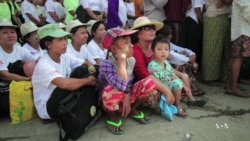KANGYIDAUNG, BURMA —
Burma is preparing for a landmark national census, the first in three decades, that will guide a wide range of government policies in the coming years. School teachers from around the country have been recruited to carry out the door-to-door count starting at the end of March. In the Irrawaddy Delta authorities are trying to educate people about the importance of the process.
A road show of comedians and singers is raising awareness about the long-awaited process, which is a foreign concept to many people here like Htay Ko. "I think this census is a good thing because then we can finally know how many people there are in Burma," he said.
School teachers from around the country spend five days in training to learn to fill out the 41 questions on the form.
The questionnaire covers a broad range of information, including details about ethnicity and religion. Those elements have drawn concern from many who worry it could worsen Burma’s ethnic and religious tensions.
Part of Aye Pa Pa Htay's training, a census worker in the Irrawaddy River Delta, is how to handle sensitive questions.
"I haven't directly encountered fears, but I know some issues and problems have already arisen, but the training can provide the enumerators with skills to respond very well to the ethnicity question," explained Aye Pa Pa Htay.
Large swaths of the country's border areas where ethnic minorities live were left out of the counting in 1983 due to civil war.
Although ongoing fighting has prevented parts of Kachin state from participating, Frederick Okwayo, the top technical advisor to the Department of Population, said this census will provide a more complete snapshot of the population.
"The first important thing is to get the actual number of population who are staying in the country by areas because any planning... you require how many people are there," he stated.
Until now, population data in Burma has been notoriously unreliable, making development planning very difficult.
As the country emerges from decades of mismanagement under military rule, supporters hope the new census will lead to better governance, without worsening ethnic and religious tensions.
A road show of comedians and singers is raising awareness about the long-awaited process, which is a foreign concept to many people here like Htay Ko. "I think this census is a good thing because then we can finally know how many people there are in Burma," he said.
School teachers from around the country spend five days in training to learn to fill out the 41 questions on the form.
The questionnaire covers a broad range of information, including details about ethnicity and religion. Those elements have drawn concern from many who worry it could worsen Burma’s ethnic and religious tensions.
Part of Aye Pa Pa Htay's training, a census worker in the Irrawaddy River Delta, is how to handle sensitive questions.
"I haven't directly encountered fears, but I know some issues and problems have already arisen, but the training can provide the enumerators with skills to respond very well to the ethnicity question," explained Aye Pa Pa Htay.
Large swaths of the country's border areas where ethnic minorities live were left out of the counting in 1983 due to civil war.
Although ongoing fighting has prevented parts of Kachin state from participating, Frederick Okwayo, the top technical advisor to the Department of Population, said this census will provide a more complete snapshot of the population.
"The first important thing is to get the actual number of population who are staying in the country by areas because any planning... you require how many people are there," he stated.
Until now, population data in Burma has been notoriously unreliable, making development planning very difficult.
As the country emerges from decades of mismanagement under military rule, supporters hope the new census will lead to better governance, without worsening ethnic and religious tensions.










